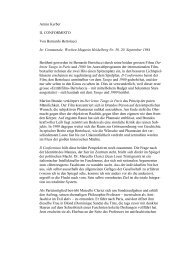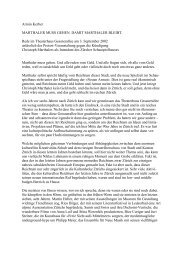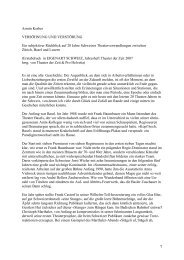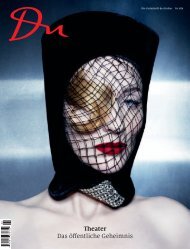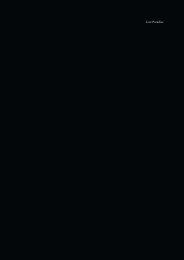You also want an ePaper? Increase the reach of your titles
YUMPU automatically turns print PDFs into web optimized ePapers that Google loves.
<strong>Lost</strong> <strong>Paradise</strong> – “Tu n’as rien vu à Hiroshima”<br />
in Switzerland. After complicated proceedings – in 1945 it was difficult<br />
to contact Adorno from Europe as he lived in the U.S. – Benjamin’s socalled<br />
“Parisian estate” or “First Parisian estate” was at last handed over<br />
to Adorno in early 1947, together with Angelus novus, by the wife of a<br />
member of the Paris U.S. embassy who had taken it to the U.S. with her.<br />
It was through Adorno that Angelus novus finally came to Scholem. In<br />
1982, after Scholem’s death, the watercolour drawing was exhibited for<br />
the first time at the Israel Museum in Jerusalem. In 1987 it came into the<br />
museum’s possession as a gift by Fania and Gershom Scholem, John and<br />
Paul Herring as well as Jo-Carole and Ronald Lauder.<br />
The “Angel of History” — As Johann Konrad Eberlein and, more recently,<br />
Oskar Bätschmann have pointed out, it is Walter Benjamin’s lifelong<br />
historical, philosophical, aesthetic and political reflections on Klee’s watercolour<br />
that have turned Angelus novus into an icon representing the<br />
20th century’s sheer violence and unfettered brutality inflicted on the<br />
powerless: according to some passages in Benjamin’s letters to his friend<br />
Scholem, the philosoper appreciated Klee and his art from a very early<br />
stage. To Benjamin, Klee was the modern artist incarnate, one who based<br />
his art on technique and science, and whose “surrealist cross-fades” characterised<br />
the sensual world while capturing the real, present-day world.<br />
Benjamin read books about Klee and his letters frequently mention the<br />
artist. So, although it was to be expected that he would dedicate much<br />
thought to Angelus novus, it is nonetheless surprising to see how much<br />
room he gave to interpretations of this work in his thinking, and how far<br />
he was to go.<br />
The angel’s wide-open button eyes see the one disaster, but they do<br />
not reflect it. In its turn, the exhibition <strong>Lost</strong> paradise, using artefacts by<br />
artists from the 20th and 21st centuries, attempts to reconstruct a rough<br />
panorama of what the “Angel of History” can see, i.e. the firestorm and<br />
naked survival of human beings erring about a world fraught with destruction.<br />
Even before Benjamin’s interpretation of the angel, Scholem’s birthday<br />
poem for Benjamin dated July 15, 1921, perceived the angel’s eyes as<br />
black, describing him as a dark messenger – albeit not an explicitly sinister<br />
one. However, Scholem’s influence on Benjamin’s reception of Angelus<br />
does not end here. The Jewish scholar acquainted Benjamin with his theological<br />
tradition and the Kabbalistic – or rather Talmudic – legend ac-<br />
54



